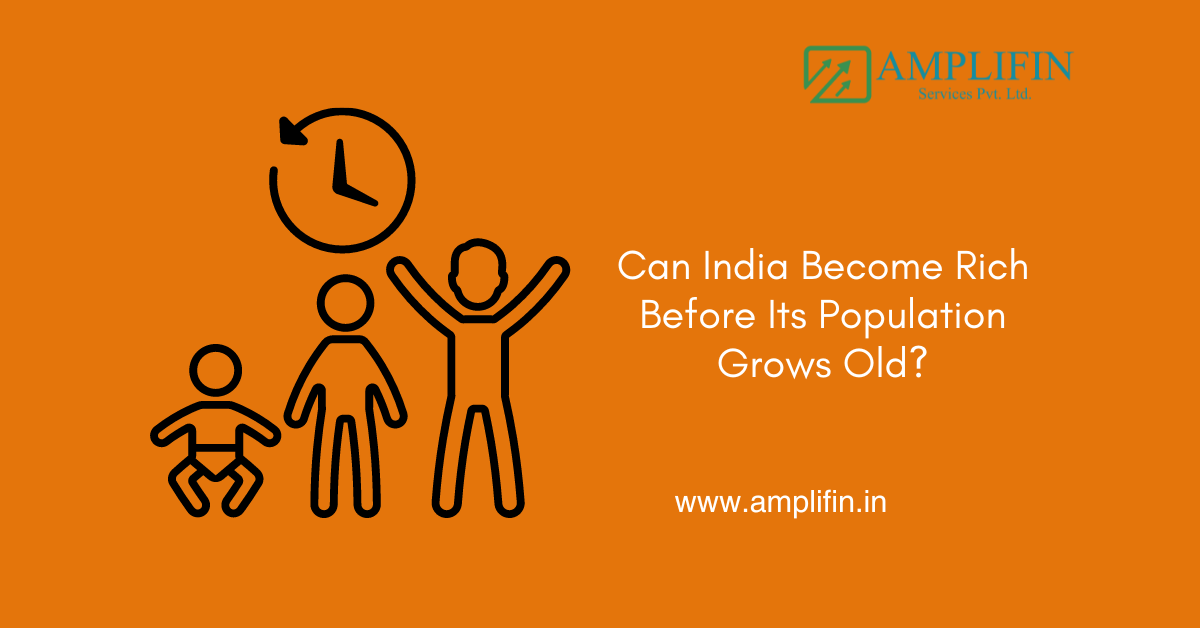Can India Become Rich Before Its Population Ages?
As India sets ambitious goals for economic growth and development, a critical question emerges: Can the world’s most populous nation achieve high-income status before its demographic dividend fades? Analysts in 2022 ponder this crucial challenge for India. This blog post explores the challenges and opportunities India faces in its journey towards becoming a developed economy, drawing insights from recent reports and expert opinions.

India’s Economic Aspirations and Current Standing
Prime Minister Narendra Modi has set a bold vision for India, aiming to transform the country into a high-income, developed nation by 2047. This goal aligns with projections that India will become the world’s third-largest economy within the next six years. Some analysts predict that by 2024, India will overtake several other large economies. However, the path to achieving this status is fraught with challenges.
Currently, India’s per capita income stands at approximately $2,400, placing it firmly in the lower middle-income category. To reach high-income status, as defined by the World Bank, India would need to achieve a per capita Gross National Income of $13,846 or more – a significant leap from its current position.
The Looming Threat of the Middle-Income Trap
Economists have been warning about the potential for India to fall into the “middle-income trap” – a phenomenon where countries struggle to maintain rapid growth and compete with advanced economies as they reach middle-income levels. This trap is characterized by:
- Escalating costs
- Loss of competitiveness
- Difficulty in transitioning to innovation-driven growth
A recent World Bank report highlights these concerns, suggesting that at the current growth rate, India would need 75 years to reach just a quarter of America’s per capita income. This sobering projection underscores the urgency of addressing the challenges that could hinder India’s economic ascent.
Global Context: Challenges Faced by Middle-Income Countries
India is not alone in facing these hurdles. The World Bank report identifies over 100 countries, including China, Brazil, and South Africa, that confront significant obstacles in their pursuit of high-income status. These middle-income countries collectively represent:
- 40% of global economic output
- Nearly two-thirds of global carbon emissions
- Three-quarters of the world’s population
- Almost two-thirds of those living in extreme poverty
The challenges these nations face are multifaceted:
- Rapidly aging populations
- Rising protectionism in advanced economies
- The urgent need for accelerated energy transition
The Importance of Middle-Income Countries in Global Prosperity
Indermit Gill, chief economist of the World Bank and co-author of the study, emphasizes the critical role of middle-income countries in shaping global economic prosperity. He notes that many of these nations rely on outdated strategies to advance their economies, often depending too heavily on investment or prematurely shifting to innovation-focused approaches.
Structural Challenges in Middle-Income Economies
One of the key issues highlighted in the World Bank report is the slow pace of business growth in middle-income countries. For instance:
- In India, Mexico, and Peru, firms typically only double in size over 40 years of operation. Analysts believe that to improve this rate, countries like India will need substantial policy reforms.
- In contrast, U.S. firms grow seven-fold over the same period.
This slow growth is reflected in the business landscape of these countries:
- Nearly 90% of firms in India, Peru, and Mexico have fewer than five employees.
- Only a small fraction of businesses in these countries have 10 or more employees.
These statistics reveal a significant challenge: while firms in middle-income countries can survive for decades, they struggle to achieve substantial growth, limiting their contribution to overall economic expansion.
A New Approach for Economic Advancement
To overcome these challenges, the World Bank researchers propose a three-pronged strategy for middle-income countries: Analysts suggest that countries like India will need to adapt such strategies for their unique contexts.
- Increase investment
- Adopt new technologies from around the world
- Foster innovation
This approach is exemplified by the success story of South Korea, which transformed its economy from a per capita income of $1,200 in 1960 to $33,000 by 2023. South Korea’s journey involved:
- Initially boosting public and private investment
- Shifting to an industrial policy that encouraged technology adoption in the 1970s
- Developing a skilled workforce to support technological advancement
The success of companies like Samsung, which evolved from a noodle-maker to a global technology leader, illustrates the potential of this strategy.
Learning from Success Stories
Other countries have followed similar paths to economic advancement:
- Poland boosted productivity by adopting Western European technologies.
- Chile encouraged technology transfer to drive local innovation, notably adapting Norwegian salmon farming techniques to become a leading salmon exporter.
These examples demonstrate that with the right strategies, middle-income countries can overcome the challenges they face and progress towards high-income status.
The Middle-Income Trap: A Historical Perspective
Research shows that countries often encounter a “trap” at around 10% of US GDP per capita (approximately $8,000 today) as they grow wealthier. This level falls squarely within the World Bank’s definition of “middle-income” countries.
Since 1990, only 34 middle-income countries have successfully transitioned to high-income status. Say India will need extraordinary measures to join this elite group. Notably, over a third of these benefited from either integration into the European Union or newfound oil reserves, highlighting the difficulty of this transition without such advantages.
India’s Path Forward: Racing Against Time
Economists Raghuram Rajan and Rohit Lamba provide a sobering perspective on India’s economic future. They estimate that even with a robust per capita income growth rate of 4%, India would only reach a per capita income of $10,000 by 2060 – a level lower than China’s current standing. Analysts argue that to overtake China economically, India will need higher growth rates and more comprehensive reforms.
The authors stress the urgency of India’s situation:
“We must do better. Over the next decade, we will see a possible population dividend, that is rise in the share of our population of working age, before we, like other countries, succumb to ageing.”
This statement encapsulates the central challenge facing India: Can the country leverage its demographic dividend to accelerate growth and achieve upper-middle-class status before its population begins to age?
Key Strategies for India’s Economic Advancement
To capitalize on its demographic dividend and avoid the middle-income trap, India needs to focus on several key areas: Analysts have highlighted that India will need robust policy interventions to succeed.
- Job Creation: Generating quality employment opportunities for its youthful population is crucial. This will not only boost economic growth but also ensure a more equitable distribution of wealth.
- Skill Development: Investing in education and vocational training to equip the workforce with the skills needed for a rapidly evolving global economy.
- Technology Adoption: Encouraging businesses to adopt and adapt global technologies to increase productivity and competitiveness.
- Innovation Ecosystem: Fostering a culture of innovation and entrepreneurship to drive the creation of high-value industries.
- Infrastructure Development: Continuing to invest in physical and digital infrastructure to support economic growth and attract investment. Say India will need to significantly enhance its infrastructure to stay competitive.
- Policy Reforms: Implementing reforms to improve the ease of doing business, attract foreign investment, and promote domestic industry.
- Sustainable Development: Balancing economic growth with environmental sustainability to ensure long-term prosperity.
Challenges and Opportunities
As India strives to accelerate its economic growth, it faces several challenges:
- Income Inequality: Ensuring that economic growth translates into improved living standards for all segments of society.
- Regional Disparities: Addressing the economic imbalances between different states and regions within the country. Analysts believe that India will need targeted regional policies to address these disparities effectively.
- Global Economic Uncertainties: Navigating the challenges posed by global economic fluctuations and geopolitical tensions.
- Climate Change: Balancing rapid industrialization with environmental sustainability and climate change mitigation.
However, India also has several advantages that could help it overcome these challenges:
- Large Domestic Market: A vast and growing consumer base that can drive economic growth.
- Young Workforce: A demographic dividend that, if properly leveraged, can boost productivity and innovation. Analysts believe that India will need to create more job opportunities to fully benefit from its young workforce.
- Digital Infrastructure: Rapidly expanding digital connectivity that can drive technological adoption and innovation.
- Entrepreneurial Spirit: A vibrant startup ecosystem that can foster innovation and job creation. Say India will need policy support to sustain its entrepreneurial momentum.
The Role of Government and Private Sector
Achieving India’s economic ambitions will require a concerted effort from both the government and the private sector:
- Government Initiatives: Continued focus on ease of doing business reforms, infrastructure development, and policies that promote innovation and skill development.
- Private Sector Investment: Increased investment in research and development, technology adoption, and workforce training by businesses.
- Public-Private Partnerships: Collaboration between government and industry to address key challenges and drive economic growth.
- International Cooperation: Engaging with global partners for technology transfer, investment, and market access.
Conclusion: A Race Against Time
As India stands at this crucial juncture, the question “Can India become rich before it becomes old?” takes on paramount importance. The country has a narrow window of opportunity to capitalize on its demographic dividend and propel itself into the ranks of high-income nations.
Success will require a multifaceted approach that combines increased investment, rapid technology adoption, and a focus on innovation. Analysts in 2022 stressed the importance of such an approach for countries like India. It will also demand a delicate balance between pursuing rapid growth and ensuring that this growth is inclusive and sustainable. Analysts in 2021 emphasized this challenge for rapidly developing countries like India.
The challenges are significant, but so are the opportunities. With the right strategies and a concerted effort from all stakeholders, India has the potential to break free from the middle-income trap and achieve its vision of becoming a developed economy.
As the world watches India’s economic journey, the outcome will have profound implications not just for the country’s 1.4 billion citizens, but for global economic prosperity and the future of developing nations worldwide.
